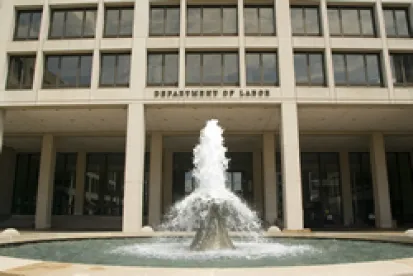The Department of Labor (DOL) has issued long-awaited guidance on “missing plan participants,” roughly six years after the agency began investigating plan fiduciaries over the issue. The guidance is particularly welcome because investigations often ended with DOL telling plan fiduciaries that their methods for locating missing plan participants were not in compliance with the Employee Retirement Income Security Act of 1974 (ERISA), even though DOL had not issued guidance yet. With the guidance now available, plan sponsor employers, multi-employer and multiple employer plans should establish and implement procedures that comply with DOL suggested best practices. Noncompliance can result in breaches of fiduciary duty and violations of Internal Revenue Service (IRS) rules. The guidance will help fiduciaries establish an appropriate process for locating missing participants and provide some assurance that the plan’s procedures are adequate.
In issuing the guidance, DOL stresses that ERISA’s fiduciary obligations fully apply to missing participants whose accounts are treated as “conditionally forfeited” under IRS regulation 1.411(a)-4(b)(6). According to DOL, plan fiduciaries retain full responsibility for adhering to ERISA’s provisions with respect to missing participants and beneficiaries. These participants and beneficiaries remain fully entitled to all of their promised benefits, and plan fiduciaries have an obligation to keep accurate records and take appropriate steps to ensure that participants and beneficiaries are paid their full benefits when due.
The guidance was not issued in the form of regulations and therefore does not carry the weight of law. Instead, DOL issued non-regulatory guidance in three parts: a list of best practices for locating and tracking participants and beneficiaries; a compliance-assistance document describing DOL’s missing-participant investigations and case-closing practices; and a field-assistance bulletin temporarily letting fiduciaries of abandoned or insolvent retirement plans off the hook for missing participant violations if the plan fiduciary complies with the guidance provided therein.
Locating missing participants is important because, under ERISA, plan fiduciaries have a duty of prudence and loyalty to participants to properly distribute all of the plan’s assets when due. To fulfil that duty, plan fiduciaries must take reasonable actions to find current and former participants and beneficiaries to whom benefits are due but who have not been located after mailing to the last known address, and to commence payment to those participants and beneficiaries. Also, plan fiduciaries should keep in mind that they must be diligent about locating and paying missing participants and beneficiaries, since fiduciaries make a representation on Form 5500 each year regarding unpaid benefits; Form 5500 contains the question, “Has the plan failed to provide benefits when due under the plan?” If the fiduciary’s answer is “Yes,” they must provide the dollar amount of the underpayment.
DOL Best Practices for Locating and Tracking Missing Participants and Retirees1
‘Red Flag’ Warnings of Problems
Based on its experience in investigating plan sponsors, DOL identified the following “red flags” that are often warnings or indicators of a problem with missing or nonresponsive participants: (1) more than a small number of missing/nonresponsive participants or terminated vested participants who have reached normal retirement age have not started receiving their pension benefits, (2) missing, inaccurate, or incomplete contact information and/or census data, and (3) the absence of sound policies and procedures for handling undeliverable mail and uncashed checks.
According to DOL, a well-run plan has best practice processes in place to make sure that plan records are complete and up-to-date, and benefits are distributed in a timely manner instead of relying on “one-time” or sporadic “fixes.” Not every best practice example listed below is necessarily appropriate for every plan. Fiduciaries should consider which practices will be cost-effective and yield the best results. The size of a participant’s accrued benefit and account balance as well as the cost of search efforts are facts to take into consideration. The following practices, based on DOL observations, have proven effective at minimizing and mitigating the problem of missing or nonresponsive participants.2
Examples of DOL Best Practices
-
Maintain accurate census information for the plan’s participant population.
-
Contact participants on a periodic basis to confirm or update their contact information (home and business addresses, telephone numbers (including cell phone numbers), social media contact information, and next of kin/emergency contact information). Include contact information change requests in plan communications along with a reminder to advise the plan of any changes in contact information. Flag undeliverable mail/email and uncashed checks for follow-up.
-
Consider maintaining and monitoring an online platform that participants can use to update contact information for themselves and their spouses/beneficiaries, and include such updates in the plan’s census information. Provide prompts to confirm contact information upon login to online platforms, request updates regularly, and audit census information and correct errors.
-
Most important, in the case of a change in record keepers or a business merger or acquisition by the plan sponsor, address the transfer of appropriate plan information (including participant and beneficiary contact information) and relevant employment records (e.g., next of kin information and emergency contacts).
Implementing Effective Communication Strategies
Among the strategies provided by DOL: use plain language and offer non-English language assistance where appropriate, state upfront and prominently what the communication is about, encourage contact through plan/plan sponsor websites and toll-free numbers, confirm or update contact information during the plan onboarding and enrollment processes for new employees, and exit processes for separating or retiring employees, provide information on how accounts from prior employers can be consolidated and clearly mark envelopes and correspondence with the original plan or sponsor name for participants who separated before the plan or sponsor name changed.
Conducting Missing Participant Searches
-
Check related plan and employer records for participant, beneficiary and next of kin/emergency contact information. Also check the employer’s payroll records or the records maintained by another of the employer’s plans, such as a group health plan, which may have more up-to-date information.
-
Check with designated plan beneficiaries (e.g., spouse, children) and the employee’s emergency contacts (in the employer’s records) for updated contact information.
-
Use free online search engines, public record databases (such as those for licenses, mortgages, and real estate taxes), obituaries, and social media to locate individuals.
-
Use a commercial locator service, a credit-reporting agency, or a proprietary internet search tool to locate individuals.
-
Attempt contact via USPS certified mail, or private delivery service with similar tracking features if less expensive than USPS certified mail, to the last known mailing address.
-
Attempt contact via other available means such as email addresses, telephone and text numbers, and social media.
-
If participants are nonresponsive over a period of time, use death searches (e.g., Social Security Death Index) and, to the extent such search confirms a participant’s death, redirect communications to beneficiaries.
-
Reach out to the colleagues of missing participants by, for example, contacting employees who worked in the same office (e.g., a small employer with one or two locations) or by publishing a list of “missing” participants on the company’s intranet, in email notices to existing employees, or in communications with other retirees who are already receiving benefits. For unionized employees, reach out to the union’s local offices and through union member communications to find missing retirees.
-
Register missing participants on public and private pension registries with privacy and cybersecurity protections (e.g., National Registry of Unclaimed Retirement Benefits), and publicize the registry through emails, newsletters, and other communications to existing employees, union members, and retirees.
-
Search regularly using some or all of the above steps.
According to DOL, if there are privacy concerns, the person engaged in the search can request that the employer or other plan fiduciary forward a letter from the plan to the missing participant or beneficiary.
When implementing the above search procedures, plan fiduciaries need to be aware of privacy concerns and that some of these procedures may invite fraudulent benefit claims.
Documenting Procedures and Actions
Finally, plan fiduciaries should reduce the plan’s policies and procedures to writing, document key decisions and the implementation of such decisions and ensure the record keeper is performing agreed upon services and identifying and correcting shortcomings in the plan’s recordkeeping and communication practices, including establishing procedures for obtaining relevant contact information held by the employer.
Compliance Assistance Release Describing DOL Missing Participant Investigations3
According to DOL, the purpose of the Compliance Assistance Release release is to ensure consistent investigative processes and case-closing practices among regional offices conducting Terminated Vested Participants Project (TVPP) audits and to facilitate voluntary compliance efforts by plan fiduciaries.
Investigations
According to DOL, TVPP investigations of defined benefit plans focus on plans that appear to have systemic issues with plan administration, particularly issues related to keeping track of terminated vested participants and beneficiaries, and timely distributing benefits. For example, a plan administrator may report a large number of retired or terminated vested participants who are entitled to future benefits (or beneficiaries, in the case of deceased former participants) on the plan’s latest Form 5500 filing, what DOL would consider a “red flag.” Similarly, when a plan sponsor faces bankruptcy or is involved in a merger or acquisition, there is an increased risk of systemic issues resulting in the loss of participant data and a failure to pay participants.
Information DOL Requests
When an investigation is opened, the investigator seeks to determine the scope of any potential problems the plan may have with recordkeeping or administration of benefits for terminated vested participants and beneficiaries. A plan may be asked to provide the investigator with the plan document, SPD (summary plan description), participant census records, actuarial reports, participant communications, documentation of its internal practices and procedures, as well as contracts with service providers involved with plan administration or locating missing participants.
How Cases Are Closed
The DOL emphasizes that after receiving all of the requested information, investigators should promptly inform the responsible fiduciaries of their findings and invite fiduciaries to discuss how they can remedy any identified problems. If the fiduciaries provide appropriate remedies for affected individuals and correct any flaws in their recordkeeping, communication, search, and other relevant policies, investigators will generally recite those corrective steps, without citing the individual plan fiduciaries for specific violations of ERISA when closing out a case.
DOL Temporary Enforcement Policy on Fiduciaries of Abandoned Insolvent Plans
DOL Field Assistance Bulletin (FAB) 2021-01 announces DOL’s temporary enforcement policy on terminating defined contribution plans’ (e.g., 401(k) plans) use of the Pension Benefit Guaranty Corporation’s (PBGC) expanded Missing Participants Program. The policy applies to fiduciaries of terminating defined contribution plans and qualified termination administrators (QTA) of abandoned individual account plans (abandoned plans).
The DOL will not pursue violations of ERISA against either responsible plan fiduciaries of terminating defined contribution plans or QTAs of abandoned plans, as described in 29 CFR 2578.1 in connection with the transfer of a missing or non-responsive participant or beneficiary’s account balance to the PBGC in accordance with the PBGC’s missing participant regulations, rather than using a fiduciary safe harbor for making distributions from such plans to an IRA, certain bank accounts, or to a state unclaimed property fund as provided under DOL regulations. A plan fiduciary or QTA who chooses to participate in the PBGC Missing Participants Program must otherwise comply with the requirements of the safe harbor regulation, except that the content of the notice to participants and beneficiaries must be modified to reflect the transfer of account balances to the PBGC, rather than to an IRA, bank or savings account, or state unclaimed property fund.
However, DOL says that this temporary enforcement policy does not preclude it from pursuing violations under ERISA for a failure to diligently search for participants and beneficiaries prior to the transfer of their account balances to the PBGC or from pursuing violations under ERISA for a failure to maintain plan and employer records.
1Missing Participants – Best Practices for Pension Plans, issued Jan. 12, 2021.
2ERISA’s fiduciary obligations apply equally to defined benefit plans and defined contribution plans, and these best practice tips apply equally to both types of plans.
3 Compliance Assistance Release No. 2021-01, January 12, 2021.




 />i
/>i

